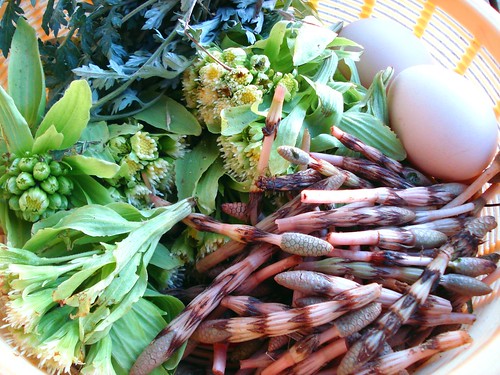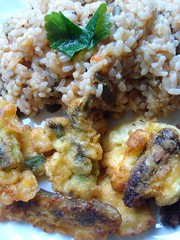Go and Gather Your Spring Dish!

If you happen to be at the Japanese countryside and you have a friendly Japanese (maybe elderly) neighbour or acquaintance - it is well worth to ask them to advise you which of the plants around you are edible. There are so many wild greens, or mountain vegetables (山菜 sansai)as they are called in Japanese, that used to be a staple for the rural poor, as well as a delicacy in the refined Japanese cuisine. Today many young city dwellers only know these green goodies as Tempura on their plates in fancy restaurants or as the ingredient of Sansai Soba soups and the like, but often they have no idea how and where those plants grow and how to prepare them.
This is a pity since it is so much fun, healthy and for free to go out and gather fresh greens in the mountains and forests of Japan! However what most people luckily still know is, when something is in season. And now it is the season for Tsukushi, Fukinotou and Taranome.
Last spring I found all of these on the premises of the little farm in Ibaraki prefecture where I worked at.
With eggs kindly donated by our chicken, brown rice and a few condiments they became some of the most delightful homemade meals of my life.
Here are the details:
Tsukushi (horse tail)
You can find lots and lots of Tsukushi sprouts on meadows and at riversides approximatly around the time of the first Sakura blossoms. They look like this [click!].
Only take the young ones which did not yet "open their heads" and cut them shortly above the ground, so that you have stem and head.
Rinse them thoroughly and remove the outer shells (hakama) that look like little crowns. You may cut the Tsukushi to about 15mm long pieces. Then soak the Tsukushi with a little soysauce, Mirin and a pinch of salt for about 30min.
In the meantime wash the rice and put it in the rice cooker with an equal amount of water. Then just add the Tsukushi together with the soysauce-Mirin-mixture and let it all cook until the rice is soft and all the water is gone. The Tsukushi should also be soft and nice now.
You can make Tsukushi Onigiri out of it or use this Tsukushi Gohan (rice dish) as a very fine complement on Tempura for example. Fukinotou
Fukinotou
Fukinotou is a rather unimpressive looking short pale yellow flower with lots of green leaves, often growing on meadows in the shade of trees or bushes. They look like this [click!]. It is best to harvest them before they are in full bloom, because they tend to be a little bitter, and the longer they bloom the more bitter they get.
The most popular way to eat Fukinotou is in form of Tempura. The batter and the frying process takes away a bit of the bitternes, resulting in just the right balance of the taste of the fresh and flowerly green and the rich yet fluffily batter.
I confess that I used a ready-made Tempura mixture (containing flour, starch, baking powder and salt in the right proportions) and I just had to add egg and cold water and stir it a few seconds with chopsticks - very easy!
After washing and draining the Fukinotou, I dipped them in the batter and then fried them quickly in hot oil. Drain the fried Fukinotou Tempura again to get rid of the excessive oil and then serve it still hot with the Tsukushi Gohan. Taranome (buds of Aralia)
Taranome (buds of Aralia)
Taranome are the buds of a very thorny bush and look like this [click!]. It is also better to harvest them early, before the grow too big, hard and woody.
They are also really delicious as Tempura.
The other greens on the first big photo above are Yomogi (mugwort) leaves. This weed grows all over Honshu in a rather epidemic way and most Japanese homegardeners hate it! However it has a nice and fresh herbal taste and is very healthy, so please try the recipe I posted before or chop it and sprinkle it on a salad, tomato salad for example. Yummy!
For more recipes and additional infos in English I recommend reading the interesting blog article.




